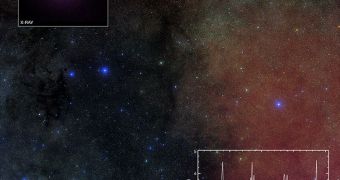A black hole astronomers became aware of only in 2003 may be the smallest such object ever discovered. According to researchers using the NASA Rossi X-ray Timing Explorer (RXTE), the structure may tip the scales at just three times the mass of the Sun.
While this may seem like a lot at first, it's actually very tiny for a black hole. In fact, strictly theoretically speaking, there can't really be any black holes that are much lighter than this. This is about the minimum amount of mass needed for the core of a collapsed star to turn into a dark behemoth.
When compared with the largest supermassive black holes ever found – which both weigh around 10 billion solar masses – the smallest one really becomes a dwarf. Astronomers say that the object is located in the direction of the constellation Scorpius.
However, the actual distance between our planet and this object has yet to be established with any degree of accuracy. Estimates vary between 16,000 and 65,000 light-years, says the international collaboration of researchers that conducted the investigation.
The smallest-ever black hole candidate is called IGR J17091-3624. Experts analyzed it by looking at a specific X-ray radiation patterns that are produced by a variety of natural phenomena around the object.
One of the things that puzzled astronomers the most was discovering that the black hole lies within a binary system. Most of the radiations and radio jets the dark behemoth produces are triggered by matter falling through its event horizon, after being removed from its companion.
However, matter does not fall directly through the event horizon, but rather accumulates into a gas disk called the accretion disk. Inside, matter experiences friction that boosts its temperature to millions of degrees. This, in turn, stimulates the emissions of powerful radiations.
The emission patterns look like an electrocardiogram, which is why experts refer to it as a heartbeat. “Just as the heart rate of a mouse is faster than an elephant's, the heartbeat signals from these black holes scale according to their masses,” Diego Altamirano explains.
The expert, who holds an appointment as an astrophysicist at the University of Amsterdam in the Netherlands, is the lead author of the new paper. The work is published in the November 4 issue of the Astrophysical Journal Letters.
In the future, data obtained from such studies could be used to gain a deeper understanding of what goes on at a black hole's event horizon.

 14 DAY TRIAL //
14 DAY TRIAL //